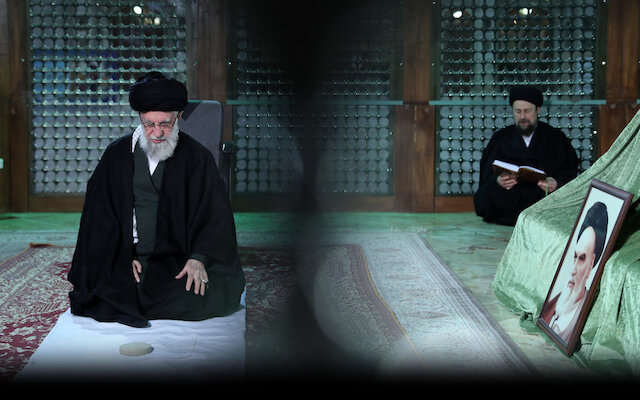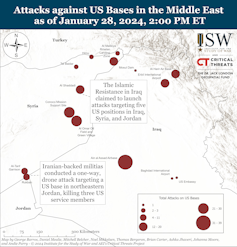Iran’s Supreme Leader at the Mausoleum of Ayatollah Khomeini, Tehran, January 31, 2024
Co-published with The Conversation, this is an update and revision of last week’s analysis, “A Weakened Iran Regime Lashes Out — and Gets Punched in the Nose”:
As tensions continue to rise in the Middle East, the world is waiting for the Biden Administration to act in response to the strike on a US base in Jordan by an Iran-backed militia on January 28, which killed three American service personnel. The US President, reportedly given several options, is weighing up deterrence of further attacks in the region against the risks of escalation.
As has so often been the case in the past, Iran has denied responsibility for the drone attack, on the Tower 22 outpost in northeast Jordan near the borders with Syria and Iraq. But the Islamic Resistance in Iraq – an umbrella group of Shia militias backed by Iran – has claimed responsibility for the attack.
Any involvement of Iran would be something of a gamble for the regime, which needs to look tough – particularly to its population ahead of elections on March 1 – but is in a weakened position. The economy is in trouble, there have been mass popular protests against the authorities’ treatment of women, and now the country has been involved in a string of foreign incidents involving Israel, the Islamic State, and Pakistan. If it sanctioned the killing of Americans, Iran may have only compounded its difficult situation.
Graphic: Institute for the Study of War
Tehran Under Pressure
On Christmas Day, Israel hit an Iranian military compound in southern Damascus, killing Sayyed Reza Mousavi. Mousavi had been the right-hand man of General Qassem Soleimani, commander of the Quds Force who was assassinated by the US in January 2020.
Nine days later, the Islamic State detonated two bombs at Soleimani’s grave in Kerman in south-central Iran on the fourth anniversary of his assassination. For the regime, Soleimani was the iconic commander who had defeated ISIS in Iraq. But far from being vanquished, the Islamic State was able to decimate his memorial, killing 91 people, with the regime apparently powerless to stop it.
Iran’s leaders and military appeared unable to protect their officers abroad or their citizens at home, let alone head the so-called “Axis of Resistance”. They needed a show of strength.
On January 15, the Revolutionary Guards fired missiles into Iraqi Kurdistan on the pretext of wiping out an Israeli intelligence cell. They killed a multi-millionaire businessman, members of his family, and other civilians including a Dutch infant less than a year old.
Just over 24 hours later, the target was the Baluchistan region in Pakistan. Regime media proclaimed a Guards missile and drone strike on a camp of the Baloch separatist group Jaish ul-Adl, which has fought security forces in southeast Iran for more than a decade. In fact, the dead included two children.
The display backfired. Needing to make its own statement over the violation of sovereignty, Pakistan’s armed forces carried out cross-border attacks in Iran’s southeastern province of Sistan-Baluchestan. They claimed “terrorists” had been killed – local media said at least three women and four children, all “non-Iranian nationals”, were slain.
On January 20, Iran’s intelligence command in Syria met in southern Damascus to consider the regional situation. They never completed the discussion. Israeli missiles destroyed the three-storey building, killing the Iranian head of intelligence, his deputy, and three other Revolutionary Guards.
Challenges for the Supreme Leader
International commentators usually treat Iran’s regime as a player in the conflict between Israelis and Palestinians. But, while ostentatiously supporting Hamas, Hezbollah and Yemen’s Houthi rebels, the regime has officially kept its distance from those groups’ operations. And the Iranian public has shown little enthusiasm for the regime’s support for Hamas – the absence of large rallies since October 7 has been marked.
The main issue is a domestic one. Soleimani has been admired by many Iranians and his anti-Islamic State legend, burnished and manipulated by the regime. And the killings from Damascus to Kerman come weeks before parliamentary elections on March 1.
The regime is seriously concerned about the prospect of another weak electoral performance, following historic lows of 42.6% in the 2020 parliamentary election and 48.8% — a drop from 72% in 2017 — in the 2021 presidential election.
But much of Iran’s electorate was alienated by the regime’s repression after the disputed 2009 presidential election. The brutal crackdown to the “Woman, Life, Freedom” protests since September 2022 has angered people further. Ahead of the poll, the Guardian Council has excluded thousands of qualified candidates, including the former president, Hassan Rouhani, to ensure the reins of power remain in the hands of hardliners.
Iran’s economy is in the doldrums amid US-led sanctions and ongoing issues of mismanagement and corruption. Inflation is officially about 40% and far higher in reality for food and other essential items. Discontent over wages and working conditions is widespread. The currency, which had stabilised after all-time lows in 2022, has lost about 10% in value in the past month.
‘Neither Gaza nor Lebanon. My Life for Iran’
But the regime persists with its tough talk. While racing to proclaim “friendship” with Pakistan, it is threatening more attacks on Iraqi Kurdistan on the pretext of dismantling Israeli intelligence networks. Iran’s President, Ebrahim Raisi, declared that Israel’s strikes “will not go unanswered”.
Tehran’s Houthi allies in Yemen are damaging international shipping in the Red Sea, site of 12% of global trade. Hezbollah is in daily skirmishes with Israel.
But Iran’s leadership is trapped in a vice. If it pulls back from direct operations, while insisting on the “independence” of its allies, it risks the appearance of being all bark and no bite across the region. If the Revolutionary Guards try another missile strike, they risk further retaliation and even defeat – whether it is from Pakistan or Israel.
So the militias in Syria and Iraq appear to have become the vehicle – and probably the sacrifice – for Iran’s leaders to signal to Iranians that they are still tough, even as they officially deny any role in the attacks.
As the US measures its response, the final word may come from Iranians whose primary concern is at home. Amid the mass protests after the disputed 2009 presidential election, they chanted: “Neither Gaza nor Lebanon. My life for Iran.” Khamenei and his inner circle are gambling that they can finally bury that message.![]()



“But much of Iran’s electorate was alientated by the regime’s repression after the disputed 2009 presidential election.”
They still came out to vote in the 2012 and 2013 elections with 63% and 73% of the vote, respectively. Iran has had low turnouts before such as local elections held in 2003 when just 10% of Tehranis came out to vote. This was during Khatami’s “popular” time in office.
US ground troops have been killed from the air for the first time since 1953, with the US military powerless to prevent these drone attacks from causing damage. Biden has telegraphed his retaliatory response, allowing the Iranians to move personnel and equipment away from sites he is likely to bomb. Meanwhile the Israelis, for all their genocide and ethnic cleansing in Gaza, are increasingly bogged down in a quagmire and looking for a way out with a hostage deal.
Another IRGC Man In Syria Killed In Airstrike Attributed To Israel
https://www.iranintl.com/en/202402027363
You should count your blessings for israel being “bogged down”, or you wouldn’t be able to bury your stray irgc fast enough.